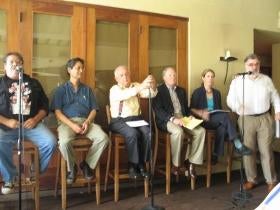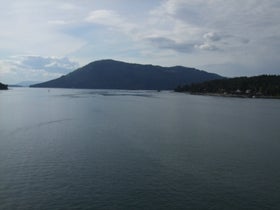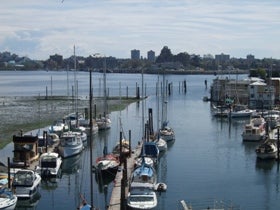 As the New England groundfish fishery moves to “sector” management (fishing cooperative-based catch shares), it’s good to get the perspective of someone with nearly a half-century of fishing experience. Frank Mirarchi, a fisherman out of Scituate, Massachusetts, describes the busts that repeatedly followed boom years. I share Frank’s optimism that sector management–once all the details are worked through–will restore the natural abundance of fish in the Gulf of Maine. This time, however, as long as sectors are well-designed and enforced, the boom years should keep going in perpetuity, moving us away from the crisis management that has marked the New England groundfish fishery for the last several decades.
As the New England groundfish fishery moves to “sector” management (fishing cooperative-based catch shares), it’s good to get the perspective of someone with nearly a half-century of fishing experience. Frank Mirarchi, a fisherman out of Scituate, Massachusetts, describes the busts that repeatedly followed boom years. I share Frank’s optimism that sector management–once all the details are worked through–will restore the natural abundance of fish in the Gulf of Maine. This time, however, as long as sectors are well-designed and enforced, the boom years should keep going in perpetuity, moving us away from the crisis management that has marked the New England groundfish fishery for the last several decades.
EDFish
Selected tag(s): Catch Shares
Sage Words from an Old Timer
Is the Debate Over?
As originally posted on Grist.org
 In the current issue of Science twenty-one leading ocean scientists declared a truce—it’s as if Wile E. Coyote and Roadrunner agreed to stop the chase for a day. The paper was authored by many of the biggest names on all sides of the debate on ending overfishing—Boris Worm, Ray Hilborn, Andy Rosenberg and Chris Costello. So what are the terms?
In the current issue of Science twenty-one leading ocean scientists declared a truce—it’s as if Wile E. Coyote and Roadrunner agreed to stop the chase for a day. The paper was authored by many of the biggest names on all sides of the debate on ending overfishing—Boris Worm, Ray Hilborn, Andy Rosenberg and Chris Costello. So what are the terms?
First, they agree on what I will call a “Goldilocks” catch level (You know—not too hot, not too cold, but just right.) If we fish too much, then fish get smaller, catch levels eventually go down and lots of species end up on the road to ruin. If we fish too little, we can keep the fish in the oceans healthy, but fish for people goes way down. Fishing just right would mean aiming to catch about 20 percent of ocean fish every year. At that level, fish would be bigger, the long term catch would be stable at a high level, and the news for ecosystems—whales, dolphins, and turtles—would be good too; at least 90% of species would be at healthy levels-which is quite a bit better than we are doing now.
The second part of the paper is where the scientists waded into the hot debate on what management works to get to the Goldilocks level. The scientists looked at the big ocean places that are making progress and asked managers what worked. The first thing they found was that most places use a mix of approaches for the mix of ecosystem types-so there is not a panacea. Pretty much everyone will agree to that.
What comes out on top, though? It comes down to effectively implementing caps on catch levels using two key tools: reducing the Total Allowable Catch and putting in place catch shares. (You can look at their table where a solution was identified in at least five of the ten fisheries, and was usually ranked an “essential” part of the solution.) This is strong stuff!
There are lots of questions yet to answer—like why is it that a catch share program always had a reduced allowable catch level? Is the theory right that catch shares make it easier to set the catch level properly? And what makes it possible for enough stakeholders to agree to close off areas of the ocean? What are the keys to community co-management, which seems to work in small-scale fisheries? I expect that the scientists will go back to their corners and duke out those questions. I can’t wait.
High Country News Reports on the Successes and Challenges of Catch Shares
 The latest issue of High Country News has a good story on one type of catch share program—for crab in Alaska. I found Matt Jenkins’ take on catch shares balanced and engaging—he covers the benefits of catch shares and fairly points out some of the challenges this fishery has faced.
The latest issue of High Country News has a good story on one type of catch share program—for crab in Alaska. I found Matt Jenkins’ take on catch shares balanced and engaging—he covers the benefits of catch shares and fairly points out some of the challenges this fishery has faced.
Among Alaska crab fishermen, safety, economic stability and resource sustainability have all improved. And while crew pay has doubled, there are fewer crew jobs than there were. Jenkins also explains why crew members are finding it is a lot harder to work their way up from deckhand to captaining their own boat. (Some of the design mistakes in the crab program, I am glad to say, are not allowed under the current fisheries law.)
The good news is that well-designed catch shares have been and can be designed to protect community and crew interests too. The red snapper catch share in the Gulf of Mexico and the halibut and sablefish catch share in Alaska are good examples of how catch shares have improved economics and resource sustainability while at the same time enhancing the stability of fishing communities.
And other new ideas are being tried out across the country, including limiting consolidation, devoting a part of the quota to conservation or to address community concerns, creating community quota banks, and creating loan funds that can help keep quota in local communities. (Interestingly, the design of the crab program was determined by a special Act of Congress which helped lock in some serious problems—and the design did not include some of these creative options.)
Catch shares are already proving that they can end the race for fish and prevent – and even reverse – the global collapse of fisheries. Catch shares present a new opportunity for fisheries at a time when many ocean fisheries and the communities that depend on them face a steep decline. As more fisheries move to catch shares, careful and creative design solutions will help improve catch shares for all the stakeholders.
Restaurants and Community Working for Sustainable Fisheries Policy
 It isn’t often that a neighborhood restaurant wades into complex policy discussions about fisheries management, so kudos to Bob Klein of the traditional Italian restaurant Oliveto’s in Oakland for hosting a Fisheries Forum on Saturday. The restaurant not only serves delicious, sustainable seafood – it’s also willing to go the extra mile to help educate its customers and the wider community of the importance, challenges, and opportunities of fisheries management.
It isn’t often that a neighborhood restaurant wades into complex policy discussions about fisheries management, so kudos to Bob Klein of the traditional Italian restaurant Oliveto’s in Oakland for hosting a Fisheries Forum on Saturday. The restaurant not only serves delicious, sustainable seafood – it’s also willing to go the extra mile to help educate its customers and the wider community of the importance, challenges, and opportunities of fisheries management.
EDF’s marine ecologist Rod Fujita and Pacific Ocean program director Johanna Thomas were invited to be panel participants, along with Erika Feller of The Nature Conservancy, Zeke Grader of the Pacific Coast Federation of Fishermen’s Associations and Larry Collins, a crab fisherman from the San Francisco Bay Area. The panel was moderated by Ed Ueber, a former manager of the Cordell Bank Marine Sanctuary.
About 30 people showed up at Oliveto’s to learn about the potential of catch share programs – like the recently approved West Coast groundfish IFQ — and community fishing associations – like the innovative Cape Cod Hook Association — to improve the economics and sustainability of fishing along the Pacific coast. Following the panel discussion, participants were treated to an amazing Italian Riviera-style fisherman’s stew comprised of all local fish-rockfish, squid, and clams – with wild fennel pollen, saffron, and olives.
Bravo to Oliveto’s and all the participants for their commitment to providing fresh, local, delicious and sustainable seafood from the Bay Area and the California Coast. Hopefully the good meal and good discussions were the beginning of a fresh dialogue, as we all have a stake in preserving California’s rich fishing communities.
A Cautionary Tale About the New Study from Ecotrust Canada
 I just read A Cautionary Tale About ITQ’s in BC Fisheries by Ecotrust Canada. What struck me most is that we seem to be moving beyond the debate about whether catch shares provide conservation benefits. It’s clear that they do.
I just read A Cautionary Tale About ITQ’s in BC Fisheries by Ecotrust Canada. What struck me most is that we seem to be moving beyond the debate about whether catch shares provide conservation benefits. It’s clear that they do.
In the paper, Ecotrust affirms the conservation benefits of ITQs, Individual Transferable Quotas, one form of a catch share:
“[ITQs] make fishermen responsible for keeping within an individual catch limit thereby ensuring that the entire fleet stays within a strict TAC [total allowable catch].”
The article goes on to say that, for this reason, ITQs have been good for conservation. It also says that ITQs can increase the economic performance of a fishery.
As catch shares become more common, a close look at particular aspects of catch share design can help create a healthy dialogue about how best to fine-tune the programs. We should aim to optimize conservation benefits while ensuring the highest possible benefits for fishing communities.
 Ecotrust highlights that catch shares have led to increases in the value of fisheries. Significant societal benefits are associated with these changes, including providing fishermen and crew with more stable jobs; providing opportunities for creative business innovations; more highly valued seafood; and increased investment in modernizing fishing boats and gear. However, Ecotrust focuses on the economic impacts on a specific group of stakeholders in fisheries: primarily fishing crews. Ecotrust’s central complaint is that the practice of leasing quota share disadvantages British Columbia fishing crews, compared to share owners or other stakeholders.
Ecotrust highlights that catch shares have led to increases in the value of fisheries. Significant societal benefits are associated with these changes, including providing fishermen and crew with more stable jobs; providing opportunities for creative business innovations; more highly valued seafood; and increased investment in modernizing fishing boats and gear. However, Ecotrust focuses on the economic impacts on a specific group of stakeholders in fisheries: primarily fishing crews. Ecotrust’s central complaint is that the practice of leasing quota share disadvantages British Columbia fishing crews, compared to share owners or other stakeholders.
The design of any fishing regulation should be as fair as possible with regard to participation by all of society in the economic upside of well-managed fisheries. Most unfair of all would be to continue managing our fisheries on an unsustainable course.
The paper points to specific solutions to the concern of fairness in catch shares: including community hold backs, direct community allocations, owner-on-board requirements, territorial use rights and other mechanisms. EDF has advocated and even pioneered these types of tools in past and current catch share design processes. Our goal, which we share with Ecotrust and many other fishery stakeholders, is to maximize the positive socio-economic outcomes and minimize the negative ones — once conservation performance is assured.
SeafoodSource.com Suggests Seafood Buyers Consider Catch Shares for Sustainability
Lisa Duchene, SeafoodSource’s contributing editor, shared her commentary a few days ago with the publication’s audience of commercial seafood buyers. “Does your sustainable seafood purchasing policy address ‘catch shares?’ Maybe it should,” writes Duchene.
Of course, EDF agrees. Quoting the critical study by Christopher Costello and Steven Gaines published in the journal Science, Duchene states the facts pointing toward well-designed catch shares as the sustainable solution to rebuilding our nation’s fish stocks.









